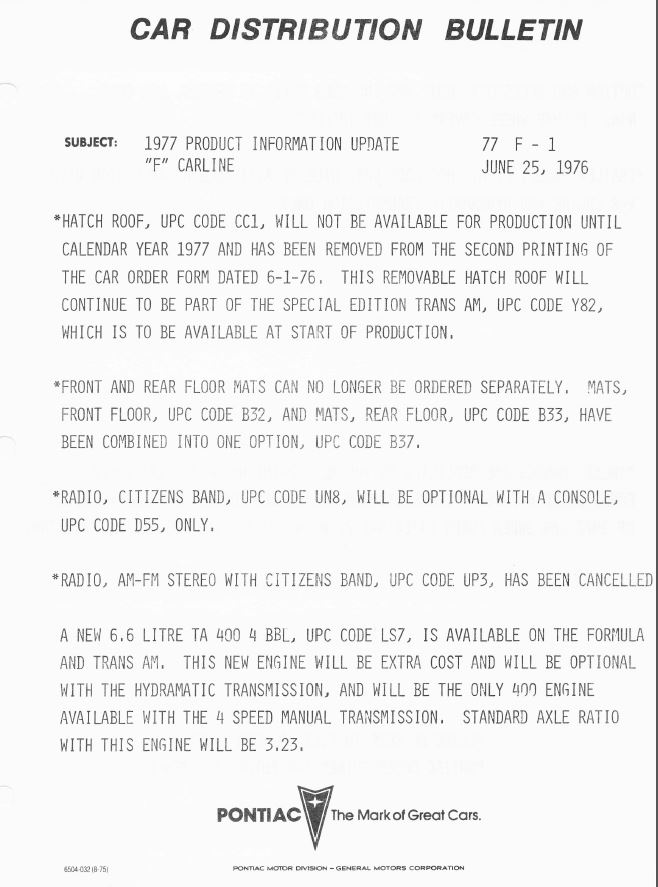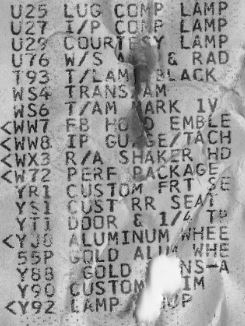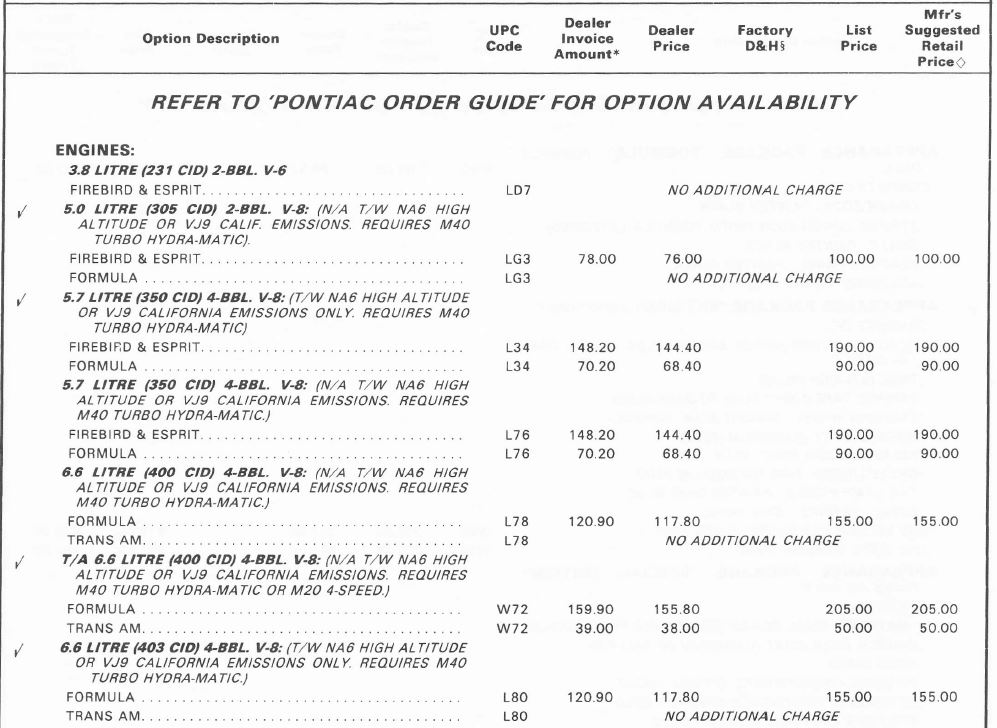
Introduction
Welcome to the T/A 6.6 Historic Information Guide. My intention in is to help establish a benchmark for accurate information about the T/A 6.6 engine as installed in the Pontiac Firebird. Over the past several years, my research of the T/A 6.6 engine has resulted in the collection of a significant amount of information about this engine package. My research is ongoing and this guide will be updated when new information is uncovered. Until then, current Firebird T/A 6.6 owners, future owners and overall Pontiac enthusiasts, I hope that somewhere in the following information, I will be able to share with you something you may not have known. This information guide was written by an enthusiast for the enthusiast and will focus on the last hiperformance 400-cid engine developed by Pontiac, the "T/A 6.6".
HERITAGE
During twelve model years (1967-1978), the durable 400-cid engines went through various stages of hi-performance development offering the enthusiasts a solid street performance engine. The likes of such hi-performance 400-cid engines developed by Pontiac during the mid-1960s until 1970 included, 400 HO, Ram Air's I, II, III, IV and V. Without question, these were some of the best hi-performance engines Pontiac ever produced.
In the early 1970s, Pontiac began to focus their performance development on the new for 1970, 455-cid engine. While the 400-cid engines were still on the Firebird option sheets, it was the 455-cid engines that became the top performance engine option in the Firebird line from 1971 thru 1976. The most famous of these hi-performance 455-cid engines were the 1971-72 455 HO and the 1973-74 SD-455. By the mid-1970s, fuel shortages and stricter emission standards took their toll on all hi-performance engines. Pontiac was not immune to this and as a result, beginning in 1975, performance took a turn for the worst; however, a new revolution in performance was about to begin. In 1975, Pontiac responded with a new 455-HO engine option for the Trans Am. And for the first time, the Firebird Formula did not share the top performance engine of the Trans Am. In reality, this 455-cid engine was the same engine you could get in the full-size Pontiac cars during that period as the automotive press was quick to point out. For 1976, the same 455 Trans Am returned, only this time, the HO designation was dropped and the shaker scoop now read 455. The 1975-76 455-cid Trans Ams were solid high-15 second quarter-mile performers right off the showroom floor, the very best Detroit had to offer during these very tough times.
During late 1975 and early 1976, Pontiac engineers knew the 455-cid engines would be phased out of production by the end of the 1976 model year production. With this in mind, Pontiac needed a new performance engine for the Firebird. Once again, Pontiac engineers chose the tried and true 400-cid engines as their new hi-performance engine. Unfortunately, just like the 455-cid engine, these engineers knew that the Pontiac 400-cid engine would also soon be phased out. After the 1976 model year, the 400-cid engines would be produced only two more model years.
Beginning with the 1977 model year, Pontiac offered a new high-performance engine option for the 400-cid engines called T/A 6.6. It was only available in the 49-state Trans Am and Formula Firebird models and standard in all 49-state Le Mans Can Am. During 1978 and 1979, the T/A 6.6 engine was again offered only in 49-state Trans Am and Formula Firebird models. By mid-1978, the automatic transmission was dropped from the option list, making the Borg-Warner Super T-10 4-speed the only transmission available with the W72 Performance Package. It appears that by the end of the1978 model year, Pontiac had 8,690 T/A 6.6 engines left for use inthe 1979 4-speed Trans Am and Formula Firebird models. It has been previously reported that according to former Pontiac employee Tom Goad, sometime during 1978, Pontiac stockpiled the leftover T/A 6.6 engines at a warehouse in Ohio for those 1979 cars. Sadly, availability of the T/A 6.6 engines ran out sometime in March or April 1979, marking the end of the last hi-performance 400 Pontiac engine. The T/A 6.6 became the last factory-installed hi-performance 400-cid engine produced by Pontiac.

OPTION CODE & PRICING
DEALER NEWS FLASH! NEW ENGINE OPTION FOR TRANS AM AND FROMULA.
Pontiac Car Distribution Bulletin 77- F-1, June 25, 1976 introduced a new 400-cid engine called T/A 6.6 and available on Trans Am and Formula at extra cost. The new engine was originally to carry UPC code LS7, but for reasons unknown around August 5, 1976 just before the release, code LS7 was changed to code W72. All of the original Pontiac build bulletins and memos identify the T/A 6.6 engine as W72 or T/A 400 in 1977-78 and L78 or T/A 400 in 1979. The T/A 6.6 engine carried UPC code W72 on the 1977-78 Firebird dealer order forms and was available only on Firebird Trans Am and Formula models, except for the 1977 Can Am. All Pontiac bulletins and memos for the 1979 model year list the T/A 6.6 engine in the dealer order guide under UPC code L78.


All 1977-79 Firebirds produced with the T/A 6.6 engine option list UPC code W72 PERF PACKAGE (NORWOOD, OH) or W72 PERFORM PKG (VAN NUYS, CA) on the factory build sheet as shown here. (Van Nuys, CA left and Norwood, OH right)
The 1977 W72 Performance Package cost $50.00 for the Trans Am and $205.00 for the Formula. It appears that early in the 1978 production, the W72 Performance Package included an additional suspension package. This new suspension carried UPC code WS6 and was called "Trans Am Special Performance Package". On the build sheet, this suspension was identified with UPC code WS6 - T/AM Mark 1V. During 1978, the WS6 suspension was available only on the Trans Am and left Firebird Formula buyers with the standard Trans Am suspension. The price of the WS6 package with the T/A 6.6 engine was $324.00 for the base Trans Am. The cost for the T/A 6.6 engine and WS6 package with the black and gold Y82/Y84 and gold Y88 special edition cars was $151.00. The reason for the difference in price is the Cast Aluminum Wheels are included with the Y82/Y84 and Y88 packages.
According to Pontiac Car Distribution Bulletin, February 22, 1978, to Pontiac Dealers, the T/A 6.6 engine option would no longer require UPC code WS6. A build sheet from a 1978 W72 Y84 Trans Am produced on January 8 1978 at the Van Nuys CA assembly plant does not have the WS6 option. According to Pontiac Car Distribution Bulletin 78-F-12, November 22, 1977, the last date to preference an Y82/Y84 car was November 30, 1977. The Y84 was finally released for production on November 29, 1977, one day before the order cut off date. In addition I personally know of a 1978 Trans Am with the W72 Performance Package ordered in mid-October 1977 without WS6. So it would appear as early as October/November 1977, a 1978 T/A 6.6 Trans Am could be ordered without WS6. To date I have not been able to locate any Pontiac documents earlier than the February bulletin. The cost for the T/A 6.6 engine alone during 1978 was $75.00 for the Trans Am and $280.00 for the Formula.
Pricing for 1979 was a little different than in 1977 and 1978. The L78 T/A 6.6 option cost $90.00 for the Trans Am, but required the WS6 Handling Package at $434.00 for a total cost of $524.00. The WS6 name was revised for 1979 from Trans Am Special Performance Package to Special Performance Package since it was now optional on the Firebird Formula. On the 1979 Tenth Anniversary Trans Am, the WS6 Package was standard, so the W72 option was $90.00. There was a $103.00 credit for cruise control, which was standard with the Tenth Anniversary Trans Am Package but was not available with the 4-speed transmission. The Y84 Special Edition Trans Am with the T/A 6.6 engine included the J65 disc brake rear axle, so the WS6 Package was only $250.00. Add the $90.00 L78 option and the total cost for a T/A 6.6 Y84 Trans Am was $340.00. The 1979 Formula T/A 6.6 package price was $370.00 plus $434.00 for the mandatory WS6 Package and $63.00 for required limited slip differential, for a total of $867.00.

1977 UPC Code – W72 (shown right)
Trans Am - $50.00
Formula - $205.00
1978 UPC Code – W72
Trans Am with UPC code WS6 ($249.00) - $324.00
Trans Am with UPC code WS6 and UPC codes Y82, Y84, Y88 - $151.00
Trans Am without UPC code WS6 - $75.00
Formula - $280.00, (UPC code WS6 was only available on Trans Am)
1979 UPC Code – L78/W72
Trans Am - $90.00 with mandatory UPC WS6 ($434.00) - $524.00
Trans Am UPC code Y84 with mandatory UPC WS6 ($250.00) - $340.00
Trans Am UPC code Y89 with mandatory UPC WS6 (standard) - $90.00
Formula - $370.00 plus mandatory UPC WS6 & G80 ($434.00 + $63.00)867.00
400-CID ENGINE INFORMATION
All blocks used for the T/A 6.6 engines were cast at Pontiac Engine Plant 6 with final machining assembly at Pontiac Engine Plant 9. Both plants were located in Pontiac MI. Research shows that all 400-cid engine blocks used for the 1977-79 T/A 6.6 engines were cast through November 1977. The final casting day appears to have been on a Sunday in late November 1977. Pontiac employee Dimitrie Toth Jr. witnessed as the final 400-cid blocks were coming down the line, workers quietly shut down the machines used to produce the blocks as they pasted the different assembly process. According to Toth, it appears the final 400-cid engine blocks; those to be used for the 1979 model year were machined sometime around July 1978. During that period in time, this manufacturing plant featured completely modernized and automated measuring and assembly equipment using supercomputers. The T/A 6.6 engine was not a special "hand-built" or "selectfit" engine, it did receive a great deal of super detailing and reliability training from the Pontiac engineering department.
The T/A 6.6 and base L78 400-cid engines used the same 4.1212 x 3.750 bore and stoke. The factory deck clearance was .0038 above block and the firing order was 1-8-4-3-6-5-7-2. Even though both 400-cid engines used the same aluminum alloy, cam ground slipper type tin-plated pistons; the T/A 6.6 engines used molly filled cast iron, reverse twist, taper face tin-plated compression piston rings with a .015-inch gap. The base L78 400-cid engines used cast iron; reverse twist molly channel barrel face piston rings with a .019-inch gap. In addition, the T/A 6.6 engines also used SAE 1016 locked in rod (press-in) piston pins. Both 400-cid engines used standard cast Arma Steel connecting rods with Moraine 400 steel backed main bearings. In addition, a standard nodular cast iron crankshaft with Moraine 400 steel backed main bearings was used in both 400 engines. The number 1-3 journal diameter and bearing overall length measured 3.00x.94, the number 4 journal measured 3.00x1.13 and the number 5 journal measured 3.00x1.59. The crankpin journal diameter measured 2.25 inches.
| Part No. | Part | Color Code |
| 544082 | Connecting Rod Bolt | |
| 522691 | Connecting Rod Nut | |
| 5467993 | Connecting Rod Bearing Assy. | |
| 9772783 | Piston Pin | |
| 497034 | Pistons Standard | |
| 493913 | Oil Ring Expander | Yellow |
| 490192 | Oil Ring Segment | Red |
| 9789691 | Compression Ring Upper | Red |
| 9786622 | Compression Ring Lower | Yellow |
| 497038 | Pistons .005 Oversize | |
| 494630 | Oil Ring Expander | Yellow |
| 490193 | Oil Ring Segment | Red |
| 9789692 | Compression Ring Upper | Red |
| 9786623 | Compression Ring Lower | Yellow |
The T/A 6.6 engine differed from the base 6.6 Litre engine in several ways. Unique to the T/A 6.6 was a set of smaller chambered 350-cid 6X4 heads that measured between 91 and 93cc. Officially, Pontiac released the 6X4 head combustion chamber measurements at 93.78 cc. The base 6.6 Litre engine used the larger combustion chamber 6X8 heads that measured between 98 and 101 ccs. These smaller chambered heads helped boost the compression ratio from 7.6:1 to an advertised 8:1. In addition to the smaller chambered heads, a specific camshaft was installed which produced a longer intake and exhaust duration than the camshaft used in the base 6.6 Litre. The T/A 6.6 also used a specific Rochester 800-CFM carburetor and had a higher capacity 60-psi oil pump that allowed plenty of oil pressure to vital engine parts during higher RPM conditions. A harmonic balancer with factory part number 477682 was used to help prevent the engine from shaking it self-apart during higher RPM use.
A little know fact was the use of slotted spring pin main bearing cap dowels on some T/A 6.6 engines in place of the solid dowel type used on the base 6.6 Litre engine block. Starting in 1975, Pontiac reportedly removed material from its engine blocks in order to make them lighter resulting in potentially weaker blocks as compared to the earlier blocks. According to some knowledgeable sources, the use of these spring pin dowels actually helped induce less stress into the main bearing webs of these weaker blocks during the higher RPM operating limits of the T/A 6.6 engines. These same sources say, while the spring pin dowels work well for street performance applications, these pins should not be used on racing engines. It is important to note that according to a Pontiac engineering document, it appears all T/A 6.6 engines built prior to September 28, 1976 used the same solid dowel caps as the base 6.6 Litre. The factory part number for the spring pin dowel appears to have been 527373. It appears General Motors discontinued the spring pin dowels in October 1987. These pins have been found in the 1977 number 500557 blocks used for the W72 Performance Package. It is unclear as to why Pontiac changed to a different engine block for the 1978 model year since all 400-cid blocks used for the W72 Performance Package would be cast only through November 1977. It appears the 1978 XX 481988 blocks did not have material in the web area removed like the 1977 500557 blocks. The reason for the change is unclear. Finally, according to a Pontiac technical memo dated early 1979, we do know that crankshaft and main bearing failures occurred on some 400-cid engines (including T/A 6.6 engines) used during the 1978 and possibly early 1979 model year. It is thought that improper torque setting on the main bearing caps may have been the cause. At the time of the report, Pontiac was unable to go back and examine production procedures since build out of the 400-cid engines had been completed.
HERITAGE
More coming soon....../p>